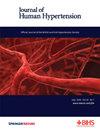Clustering of 24H movement behaviors associated with clinic blood pressure in older adults: a cross-sectional study
IF 2.7
4区 医学
Q2 PERIPHERAL VASCULAR DISEASE
引用次数: 0
Abstract
Physical activity (PA), sedentary behavior (SB), and sleep duration are known to have an individual effect on clinic blood pressure (BP) of older adults. However, whether different patterns of these so-called movement behaviors over the 24h-cycle on BP remains poorly investigated. The study aimed to identify movement behavior patterns associated with clinic BP among older adults with chronic diseases. Cross-sectional study with 238 older adults (80.3% female; mean age 68.8 ± 6.6) with at least one chronic disease. PA, SB, and sleep duration were measured by a triaxial accelerometer. Clinic systolic BP (SBP) and diastolic BP (DBP) were obtained through an automated method following standard procedures. Non-hierarchical K-means cluster and linear regression modeling were employed to identify the clusters of movement behaviors and to examine the associations. Two clusters were identified [active and non-sedentary, n = 103 (i.e., sufficient sleep duration, higher LPA and MVPA, and lower SB) and sedentary and inactive, n = 135 (i.e., sufficient sleep duration, lower LPA and MVPA, and higher SB). Active and non-sedentary older adults presented lower systolic BP compared to sedentary and inactive ones, even after adjustments for sociodemographic and clinical characteristics (β = 6.356; CI 95% from 0.932 to 11.779; P = 0.022). No associations were found for diastolic BP. In conclusion, higher PA and lower SB were associated with lower systolic BP in older adults with chronic diseases. However, sleep duration did not modify this association. Therefore, interventions focusing on concomitantly increasing PA levels and reducing SB should be the priority for controlling blood pressure.与老年人门诊血压相关的 24 小时运动行为分组:一项横断面研究。
众所周知,体力活动(PA)、久坐行为(SB)和睡眠时间对老年人的临床血压(BP)有个体影响。然而,这些所谓的运动行为在 24 小时周期内的不同模式是否会对血压产生影响,目前仍鲜有研究。本研究旨在确定患有慢性疾病的老年人中与临床血压相关的运动行为模式。横断面研究对象为 238 名至少患有一种慢性疾病的老年人(80.3% 为女性;平均年龄为 68.8 ± 6.6)。通过三轴加速度计测量了PA、SB和睡眠时间。临床收缩压(SBP)和舒张压(DBP)通过自动方法按照标准程序获得。采用非层次 K-均值聚类和线性回归模型来确定运动行为聚类并检验其关联性。结果发现了两个群组[活跃和非久坐,n = 103(即睡眠时间充足、LPA 和 MVPA 较高、SB 较低);久坐和非活跃,n = 135(即睡眠时间充足、LPA 和 MVPA 较低、SB 较高)]。即使对社会人口学和临床特征进行调整后(β = 6.356;CI 95% 从 0.932 到 11.779;P = 0.022),活跃和非久坐老年人的收缩压仍低于久坐和非活跃老年人。舒张压没有相关性。总之,在患有慢性病的老年人中,较高的 PA 和较低的 SB 与较低的收缩压有关。然而,睡眠时间并不能改变这种关联。因此,在控制血压时,应优先考虑同时提高 PA 水平和降低 SB 的干预措施。
本文章由计算机程序翻译,如有差异,请以英文原文为准。
求助全文
约1分钟内获得全文
求助全文
来源期刊

Journal of Human Hypertension
医学-外周血管病
CiteScore
5.20
自引率
3.70%
发文量
126
审稿时长
6-12 weeks
期刊介绍:
Journal of Human Hypertension is published monthly and is of interest to health care professionals who deal with hypertension (specialists, internists, primary care physicians) and public health workers. We believe that our patients benefit from robust scientific data that are based on well conducted clinical trials. We also believe that basic sciences are the foundations on which we build our knowledge of clinical conditions and their management. Towards this end, although we are primarily a clinical based journal, we also welcome suitable basic sciences studies that promote our understanding of human hypertension.
The journal aims to perform the dual role of increasing knowledge in the field of high blood pressure as well as improving the standard of care of patients. The editors will consider for publication all suitable papers dealing directly or indirectly with clinical aspects of hypertension, including but not limited to epidemiology, pathophysiology, therapeutics and basic sciences involving human subjects or tissues. We also consider papers from all specialties such as ophthalmology, cardiology, nephrology, obstetrics and stroke medicine that deal with the various aspects of hypertension and its complications.
 求助内容:
求助内容: 应助结果提醒方式:
应助结果提醒方式:


